Swine Lighting System Standards: best Light Fixtures for Swine Building
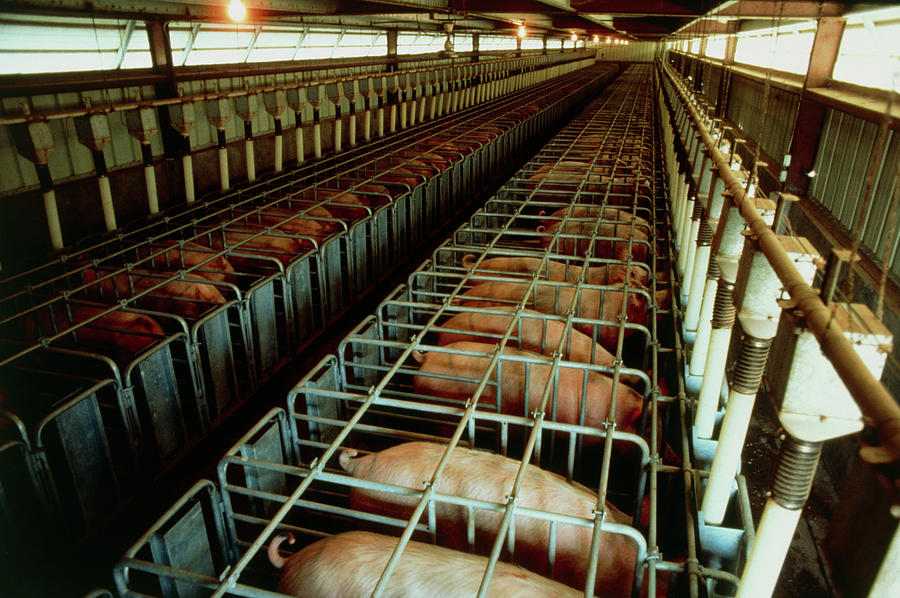
Directory:
1. Swine Lighting Standards
2. Selection and Installation of Swine Lighting Equipment
3. Common Issues and Improvement Suggestions for Swine Lighting Systems
4. best light fixtures for swine building
The lighting environment is a crucial aspect of swine housing. It is essential to determine the appropriate type of light source, the quantity needed, and the optimal placement within the swine house. With the industry's growth, there is an increasing number of large, fully enclosed swine houses where the lighting is predominantly supplied by an artificial lighting system. Therefore, designing an effective swine lighting system is becoming increasingly vital.
1. Swine Lighting Standards
To address these considerations, it is important to understand the swine lighting requirements at various developmental stages, including light intensity and duration. The author has referred to several relevant standards for guidance:
1.1 Recommendations for swine lighting from the American Society of Agricultural and Biological Engineers.
Table 1 swine lighting Standard recommendations of the American Society of Agricultural and Biological Engineers
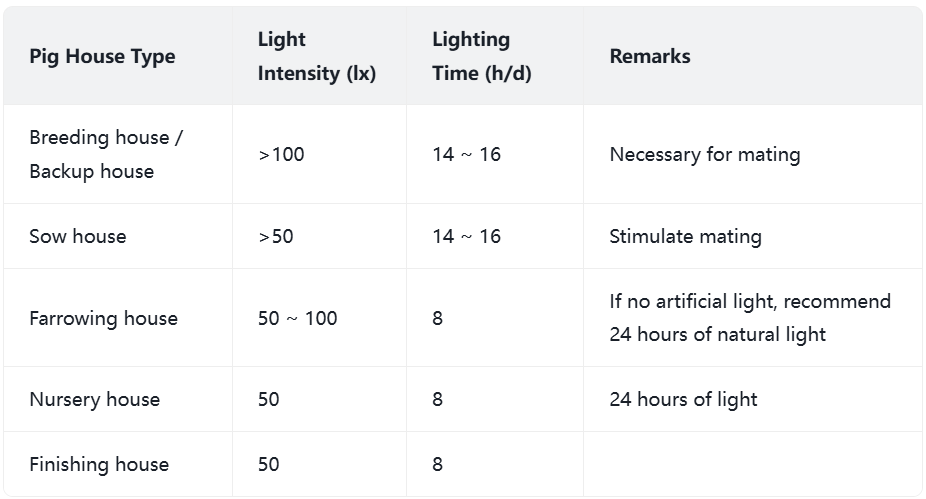
Remarks: The light intensity in farrowing and nursery houses should be reduced at night.
Table 2 Recommended swine Lighting Indexes by Canadian Swine Plan
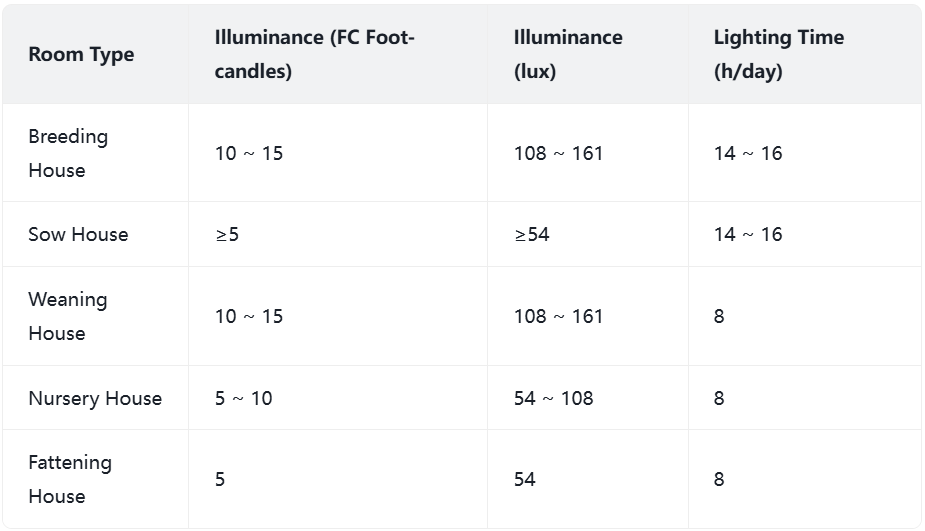
Table 3: Dr. Donald G. Levis’Recommended swine Housing Lighting Standards
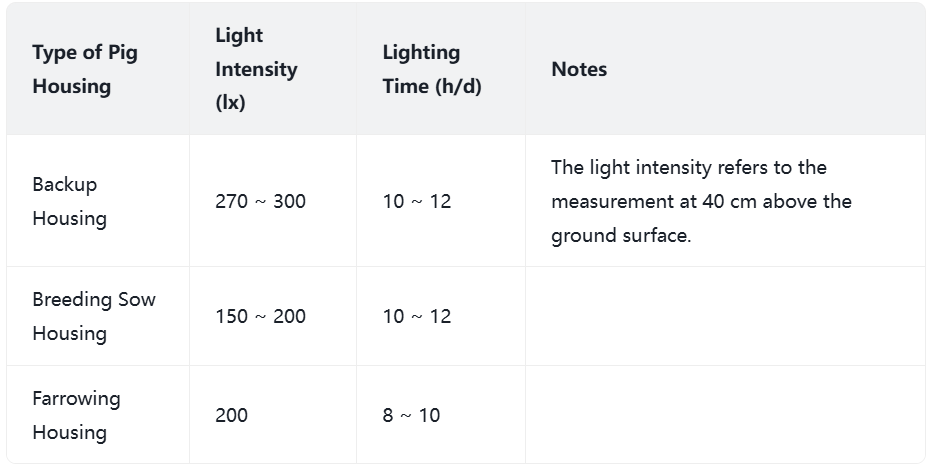
1.2 Canadian Service Plan
The light intensity in farrowing, nursery, and fattening facilities is set at 110 lx. This level is used for lamp calculations (excluding the utilization coefficient), and the actual light intensity perceived by swine is approximately 50-60 lx. During the nursing and fattening phases, light is not a critical factor, as swine can locate feed even in low light conditions. The swine lighting during this period primarily serves to assist breeding staff in monitoring the swine, identifying sick or weak individuals promptly, observing their behavior, and assessing the environmental conditions for necessary adjustments. For newly weaned swine, adequate lighting can also help them locate water sources quickly.
Research on the effects of light during the delivery phase is limited. Some studies indicate that high-intensity lighting for 16 hours at 400-500 lx may enhance a sow's feed intake and lactation, but there is no consensus on this, and maintaining high-intensity lighting over time can be energy-intensive.
The primary influence of light on swine production is observed during the reserve and breeding pregnancy stages. The reproductive performance of swine farms is influenced by seasonal changes; however, due to the interplay of thermal and light conditions, isolating the impact of light alone is challenging. In natural settings, longer daylight hours in spring and early summer can suppress wild boar estrus to prevent winter births, but this effect is harder to assess in modern production environments, and many earlier studies have not reached a definitive conclusion.
It is generally advised that replacement swine receive at least 16 hours of light exposure, or even more. Research conducted in Canada indicates that a completely dark environment can postpone swine estrus, but overall, assessing the effects of light is challenging. The table below provides a summary of findings from various studies.
table4 The estrus ratio of replacement swine under different estrus induction conditions %

Dr. Donald G. Levis concludes that for replacement swine, it is more cost-effective and efficient to provide 10 to 12 hours of light exposure at an intensity of 270 to 500 lx (using cold white fluorescent lamps) rather than the previously suggested 16 to 18 hours, while also facilitating effective boar estrus induction.
There have been studies examining the connection between light exposure and the interval between sow weaning and estrus, but no consensus has been reached.
Overall, the light environment in swine housing has a relatively minor effect on swine production compared to the thermal environment. While it may influence reproductive performance during the reserve, breeding, and pregnancy stages, there is currently no strong research backing this. This article also offers a recommended guideline for reference based on the information provided.
table5 Table 5 Recommended of swine lighting indicators
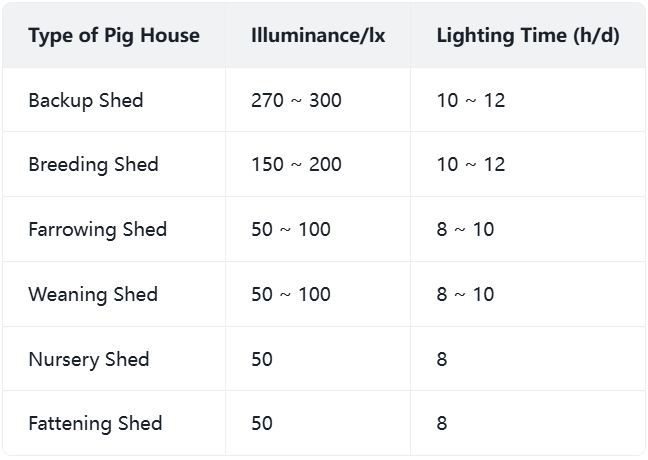
2. Selection and Installation of Swine Lighting Equipment
After understanding the swine lighting requirements, the next step is to select appropriate lighting equipment. The author offers the following guidance:
2.1 Calculating the Number of Lamps Needed
Using the fattening house as a case study, consider a house that is 60 meters long and 12 meters wide, totaling an area of 720 square meters. The ceiling height is 2.4 meters, and the required light intensity is 50 lx. The utilization coefficient, which depends on the lamp type, installation height, and reflectance of the ceiling, walls, and ground, is recommended to be 0.5 for swine houses by Dr. Jay D. Harmon. This can be adjusted by consulting a lighting engineer based on specific conditions. The total luminous flux required is calculated as follows:
Total Luminous Flux=Area×Light Intensity÷Utilization Coefficient
Total Luminous Flux=720m2×50lx÷0.5=72.000lumens
The number of lamps required is then determined based on their individual luminous flux.
2.2 Choosing the Right Lamp Type
It is advisable to select LED lamps with reliable three-proof lampshades that are waterproof, dustproof, and anti-corrosive.
2.3 Lamp Installation Methods
Most lamps are installed on the ceiling. In cases where sows are raised in stalls, additional lighting is installed above the sow’s head to ensure adequate light intensity reaches their eyes.
3. Common Issues and Improvement Suggestions for swine Lighting Systems
Currently, many swine farm projects neglect the importance of proper lighting systems in swine houses. Common issues include:
3.1 Inadequate Light Intensity
Large-span, fully enclosed swine houses often lack natural lighting and are not equipped with sufficient artificial lighting. Prolonged exposure to insufficient lighting can affect the estrus cycles of reserve swine and weaned sows. A dim environment also hinders breeders from observing the herd effectively, leading to undetected issues. Furthermore, this does not meet animal welfare standards, as laws in the UK, for example, require swine houses without natural light to provide at least 40 lx for 8 hours.
Improvement Suggestions: Assess the specific needs of the swine house and upgrade the existing lighting system accordingly. Often, simply replacing the light source can resolve the issue.
3.2 Insufficient Lighting Duration
Even when swine houses are equipped with appropriate lighting equipment, they often do not provide adequate lighting duration, which can negatively impact the estrus cycles of reserve swine and weaned sows, as well as the feeding and lactation of farrowing sows.
Improvement Suggestions: Follow the recommended lighting duration guidelines provided in this article for different types of swine houses. Implement a lighting system with a thermostat or automatic control switch to regulate opening and closing times, or enhance personnel management to ensure compliance.
4. best light fixtures for swine building


5. Related Solution & Science
6. Related Blog
Pig Farms Lighting Design: Best Light for Pig House
7. Contact Ceramiclite
